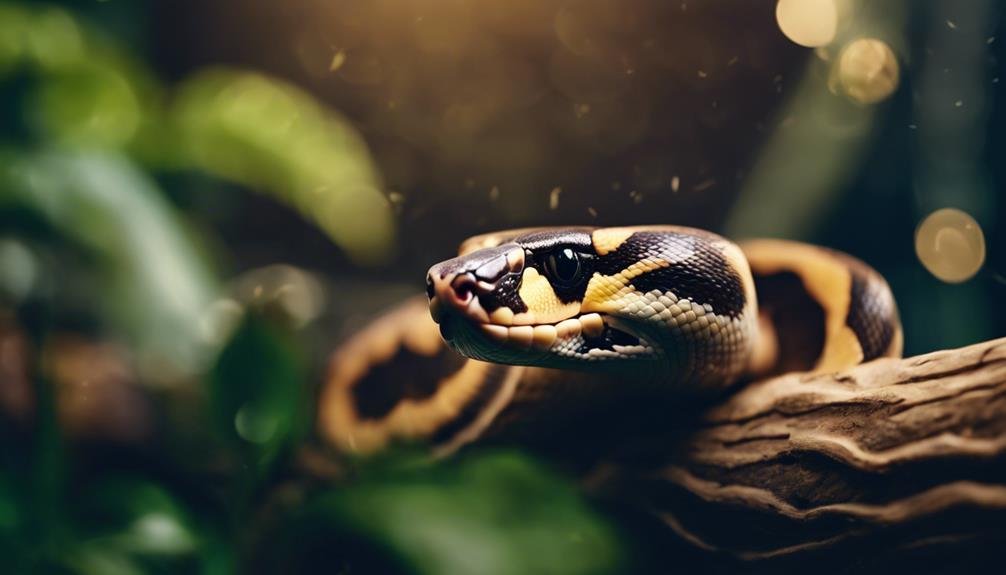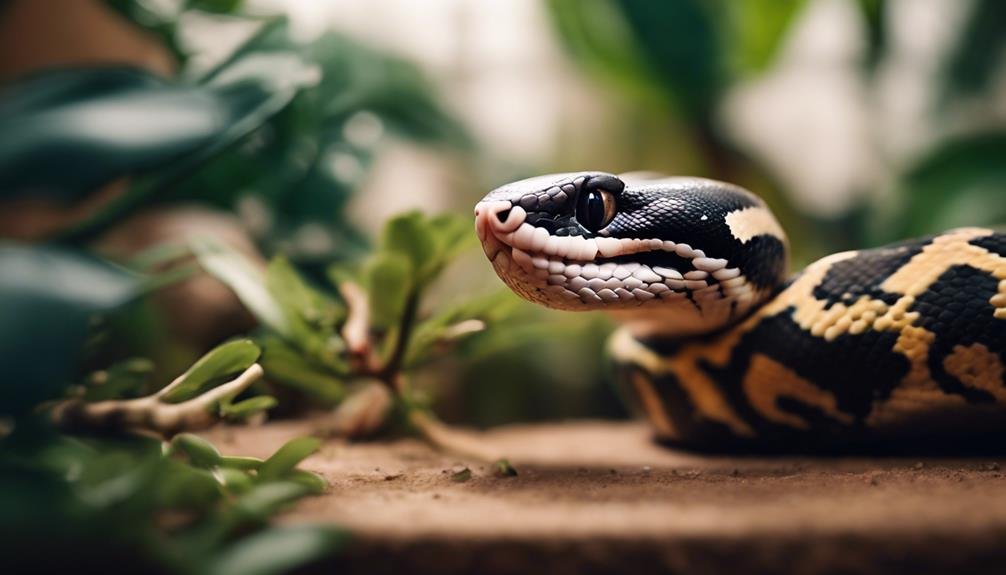Have you ever wondered if your ball python enjoys climbing? Contrary to what some may think, these fascinating creatures display a surprising affinity for elevated exploration. Being semi-arboreal, they’re naturally inclined to navigate through branches in the wild, showcasing their playful and inquisitive sides. This activity isn’t just essential for their physical and mental well-being; it’s vital. By creating a climbing-friendly habitat, you’re not only catering to their natural instincts but also enhancing their quality of life. Let’s explore how you can transform their enclosure into a stimulating environment that meets their climbing needs.
Key Takeaways
- Ball pythons are semi-arboreal, indicating they naturally engage in climbing activities.
- Climbing provides essential exercise, enrichment, and mimics their wild behavior, showcasing their inquisitive nature.
- Adding vertical elements in captivity caters to their climbing instinct and promotes physical and mental health.
- Their climbing ability reflects an evolutionary adaptation for hunting and exploration, highlighting their playful side.
- Observing ball pythons climb in captivity fulfills their natural inclination for elevated perches and arboreal prey hunting.
Understanding Ball Python Behavior
To fully appreciate ball pythons as pets, it’s important to understand their natural climbing behavior and how it influences their care in captivity. Ball pythons, with their semi-arboreal nature, aren’t just ground dwellers; they’re adept climbers who actively hunt in trees. This behavior showcases their versatility and adaptability in the wild. You might find it fascinating that these reptiles consume a variety of arboreal prey, including birds and small mammals. Their dietary preferences shift noticeably as they grow, moving from primarily avian to mammalian prey.
This shift underscores the importance of understanding their natural behaviors to replicate their diet appropriately in captivity. Providing a diet that mirrors their natural consumption patterns can contribute greatly to their health and well-being. Knowing they prefer avian prey early on can help you make more informed decisions about their feeding regimen. It’s not just about offering them food; it’s about offering the right kind of food that they’re instinctively inclined to hunt and consume. This insight into their natural dietary habits is essential for any pet owner aiming to provide the best care for their ball python.
The Climbing Instinct
Understanding their natural dietary habits provides a clear view into why ball pythons also show a strong inclination to climb, a behavior deeply rooted in their semi-arboreal lifestyle. This natural behavior isn’t just essential; it’s an evolutionary adaptation that has allowed them to thrive. Studies have thoroughly documented their ability to ascend trees in the wild, a skill they primarily use for hunting and exploration. This climbing instinct is driven by their pursuit of arboreal prey items, a fact evidenced by analysis of their stomach contents.
Both male and female ball pythons demonstrate this varied foraging strategy, incorporating their climbing habits as a critical component of their survival toolkit. Observing these snakes, you’ll notice their keen interest in investigating anything that resembles trees, an activity that mirrors their natural behavior in the wild. It’s clear that their evolutionary journey has equipped them with the skills necessary for arboreal hunting, making climbing more than just a pastime; it’s a crucial aspect of their existence.
This instinctual behavior underscores the importance of understanding and respecting the natural inclinations of ball pythons, recognizing climbing not merely as a preference but as an integral aspect of their being.
Benefits of Climbing


Climbing not only offers ball pythons essential exercise and enrichment but also closely mirrors their instinctual behaviors in the wild, enhancing their overall well-being. This activity allows your ball python to engage in normal behavior, exploring their environment vertically just as they’d in their natural habitat. It’s a vital aspect of their lives, providing both physical and mental stimulation that’s important for a healthy, happy snake.
Incorporating climbing opportunities into your pet’s enclosure helps prevent obesity and muscle atrophy, common issues in captive ball pythons that don’t have enough physical activity. It’s a proactive way to keep your slithery friend in top shape, ensuring they maintain muscle tone and stay agile. Plus, ball pythons enjoy perching and basking in elevated spots. By climbing, they can find the perfect spot to relax and soak up some warmth, mimicking their basking behavior in the wild.
Setting Up a Climbing-Friendly Habitat
Creating a climbing-friendly habitat for your ball python involves adding vertical elements like branches and vines that mimic their natural environment. By incorporating sturdy climbing structures such as logs and secure vines, you’re not only encouraging your python’s natural arboreal habits but also ensuring their safety as they explore. It’s essential that these climbing surfaces are secure and safe to prevent any falls or injuries, emphasizing the significance of a well-thought-out setup.
To further engage your ball python, creating a multi-level environment with different heights allows them to exercise their climbing instincts. This variety not only promotes mental stimulation but also simulates the diverse vertical spaces they’d encounter in the wild. It’s all about mimicking their natural habitat as closely as possible to keep them both physically and mentally healthy.
What are the Best Climbing Options for Ball Pythons in a Vivarium?
When considering ball python vivarium setup requirements, it’s important to provide climbing options for these arboreal reptiles. Utilize sturdy branches, vines, and climbing structures to create an enriching environment. Incorporating various heights and textures allows ball pythons to explore and exercise natural behaviors in their vivarium.
Observing Climbing Activities


Watching your ball python navigate its climbing structures offers fascinating insight into their natural behaviors and instincts. You’ll see firsthand how these snakes exhibit climbing behavior, not just for the fun of it, but as an essential part of their existence that aligns with their semi-arboreal nature. In the wild, they utilize trees for hunting and exploration, showing a clear adaptation to arboreal habitats. This isn’t just casual observation; scientific evidence backs up the climbing activities of ball pythons, highlighting their natural inclination for vertical movement.
Their preference for arboreal prey items further underscores the importance of climbing in their natural environment. It’s a significant connection that can’t be overlooked. That’s why providing climbing opportunities in captivity isn’t just beneficial; it’s imperative. It supports their natural instincts and behaviors, ensuring they lead happier and healthier lives.
Frequently Asked Questions
Do Ball Pythons Like Climbing?
Yes, you’ll find that ball pythons do enjoy climbing. Their wild behavior shows a semi-arboreal nature, meaning they’re used to scaling trees in search of prey or just exploring.
Providing them with climbing opportunities in captivity, such as branches or similar structures, isn’t just essential for their well-being; it’s vital. This habitat enrichment mimics their natural environment, encouraging their instinctual behaviors and making their enclosure a more stimulating home.
What Do Ball Pythons Like to Do for Fun?
For fun, ball pythons love exploring their surroundings using various exploration toys. These activities tap into their natural curiosity and keep them mentally stimulated.
By introducing items like branches, logs, and even specially designed reptile toys, you’re not only encouraging their instinct to climb but also ensuring they’re engaged and active.
This kind of enrichment is vital for their well-being, allowing them to express their playful and inquisitive side in captivity.
What Is the Best Thing for a Ball Python to Climb On?
The best thing for your ball python to climb on includes sturdy branches, climbing vines, and smooth rocks. These materials mimic their natural habitat and encourage their instinct to explore and climb. Make sure the surfaces are smooth to avoid injuring their delicate skin.
Why Is My Ball Python Climbing so Much?
If you’ve noticed your ball python climbing a lot, it might be trying to tell you something. This behavior could point to a need for more vertical space or enrichment in their home. Sometimes, it’s a sign of stress due to improper temperatures or not enough hiding spots.
You should also consider health concerns; excessive climbing might indicate an issue. Adding branches and climbing structures can help, but keep an eye on their behavior for any changes.
Conclusion
So, you’ve seen how ball pythons are naturally inclined to climb, tapping into their playful and inquisitive side. By setting up a habitat with plenty of climbing opportunities, you’re not just keeping them active; you’re enriching their lives.
Watching them explore and perch up high can be incredibly rewarding. Remember, a climbing-friendly environment isn’t just a nice-to-have; it’s essential for their well-being.
So go ahead, encourage their climbing instincts. They’ll love you for it, and you’ll love watching them thrive.


